headlights CADILLAC DEVILLE 1993 7.G Owners Manual
[x] Cancel search | Manufacturer: CADILLAC, Model Year: 1993, Model line: DEVILLE, Model: CADILLAC DEVILLE 1993 7.GPages: 406, PDF Size: 20.78 MB
Page 85 of 406
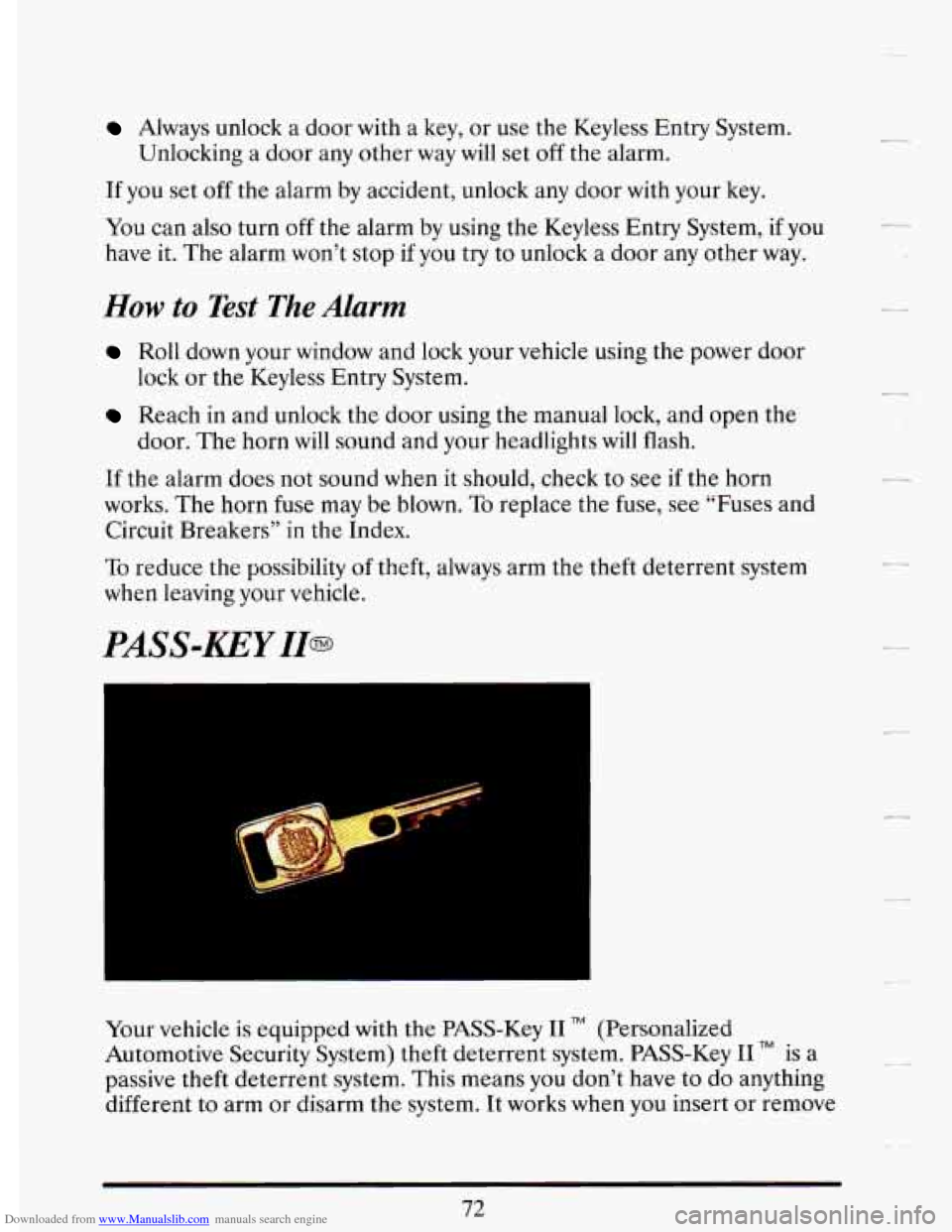
Downloaded from www.Manualslib.com manuals search engine Always unlock a door with a key, or use the Keyless Entry System.
If you set
off the alarm by accident, unlock any door with your key.
You can also turn off the alarm by using the Keyless Entry System,
if you
have it. The alarm
won’t stop if you try to unlock a door any other way.
Unlocking
a door
any other way will set off the alarm.
How to Test The Alarm
Roll down your window and lock your vehicle using the power door
Reach in and unlock the door using the manual lock, and open the
If the alarm does not sound when it should, check to see if the horn
works.
The horn fuse may be blown. To replace the fuse, see “Fuses and
Circuit Breakers”
in the Index.
To reduce the possibility of theft, always arm the theft deterrent system
when leaving your vehicle.
PASS-KEY IIm
lock or the Keyless Entry System.
door. The horn
will sound and your headlights will flash.
(Personalized
I
Your vehicle is equipped with the PASS-Key I1
Automotive Security System) theft deterrent system. PASS-Key I1 is a
passive theft deterrent system.
This means you don’t have to do anything
different
to arm or disarm the system. It works when you insert or remove
~ ~~
Page 107 of 406
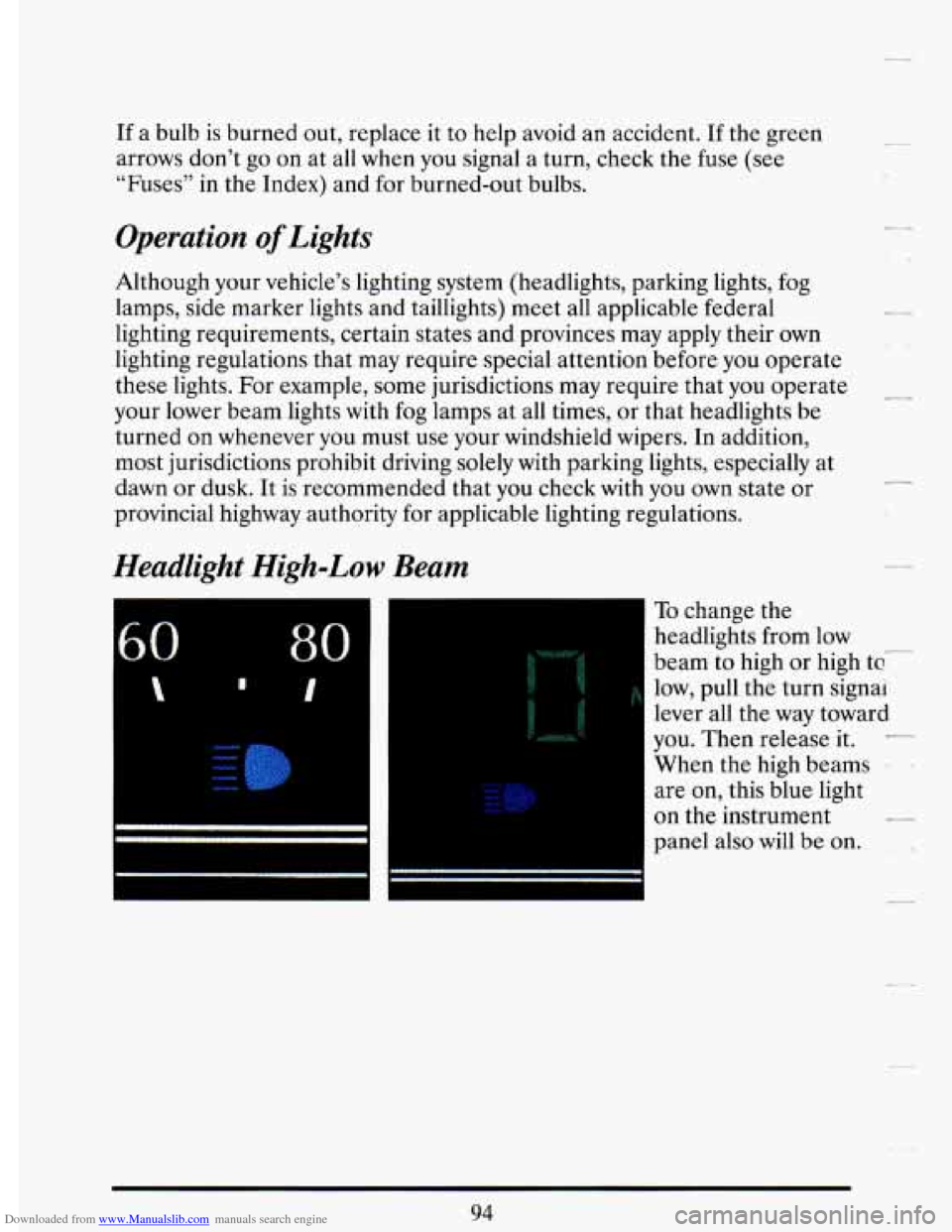
Downloaded from www.Manualslib.com manuals search engine If a bulb is burned out, replace it to help avoid an accident. If the green
arrows don’t go on at all when you signal a turn, check the fuse (see
“Fuses”
in the Index) and for burned-out bulbs.
Operation of Lights
Although your vehicle’s lighting system (headlights, parking lights, fog
lamps, side marker lights and taillights) meet all applicable federal
lighting requirements, certain states and provinces may apply their own
lighting regulations that may require special attention before you operate
these lights. For example, some jurisdictions may require that you operate
your lower beam lights with fog lamps at all times, or that headlights be
turned on whenever you must use your windshield wipers. In addition,
most jurisdictions prohibit driving solely with parking lights, especially at
dawn
or dusk. It is recommended that you check with you own state or
provincial highway authority for applicable lighting regulations.
Headlight High-Low Beam
To change the
headlights
from low
beam to high or high
6-
low, pull the turn signai
lever all the way toward
you. Then release it.
-’
When the high beams
are
on, this blue light
on the instrument
7
panel also will be on.
94
Page 117 of 406
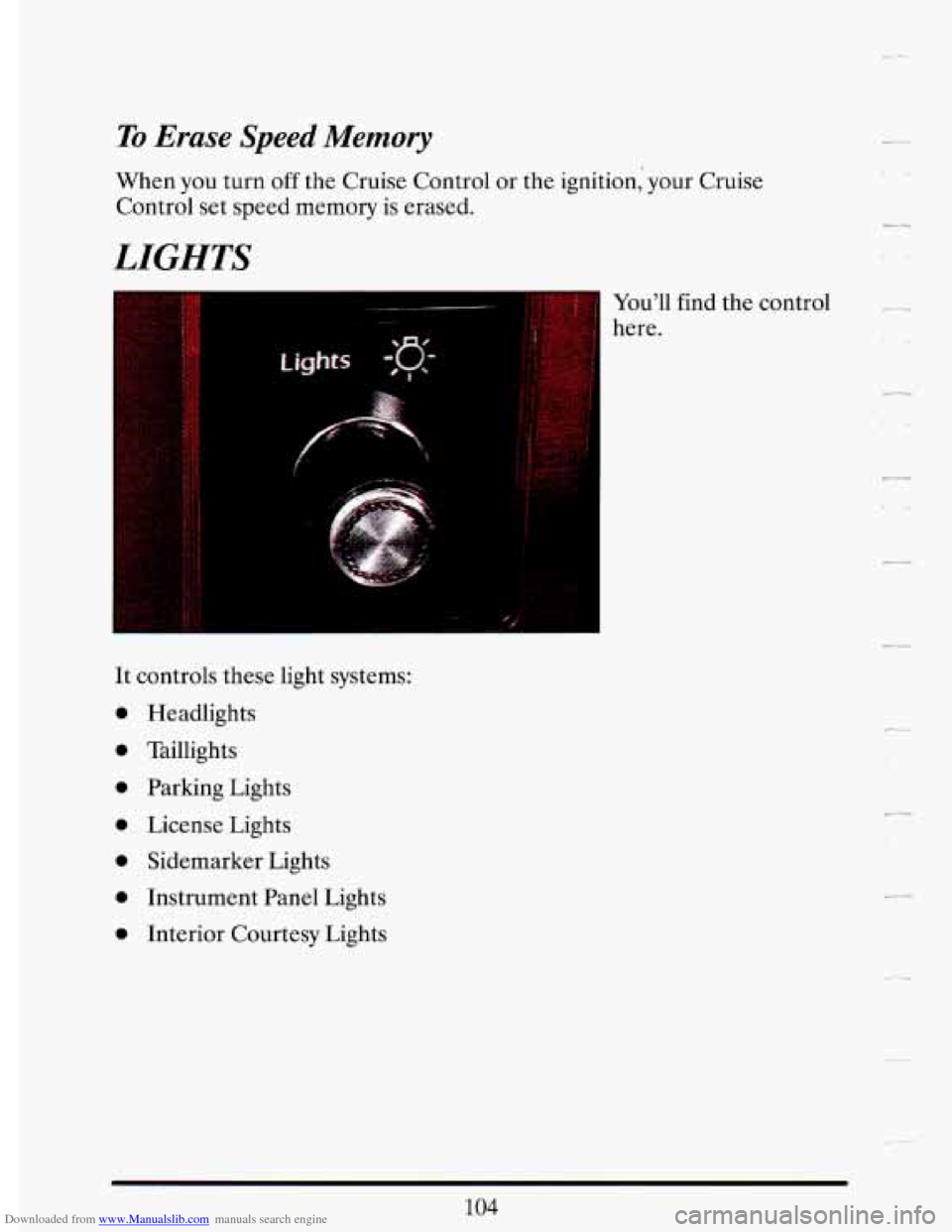
Downloaded from www.Manualslib.com manuals search engine To Erase Speed Memory
When you turn off the Cruise Control or the ignition, your Cruise
Control set speed memory is erased.
LIGHTS
You'll find the control
It controls these light systems:
Headlights
Taillights
Parking Lights
License Lights Sidemarker Lights
Instrument Panel Lights
Interior Courtesy Lights
104
Page 119 of 406
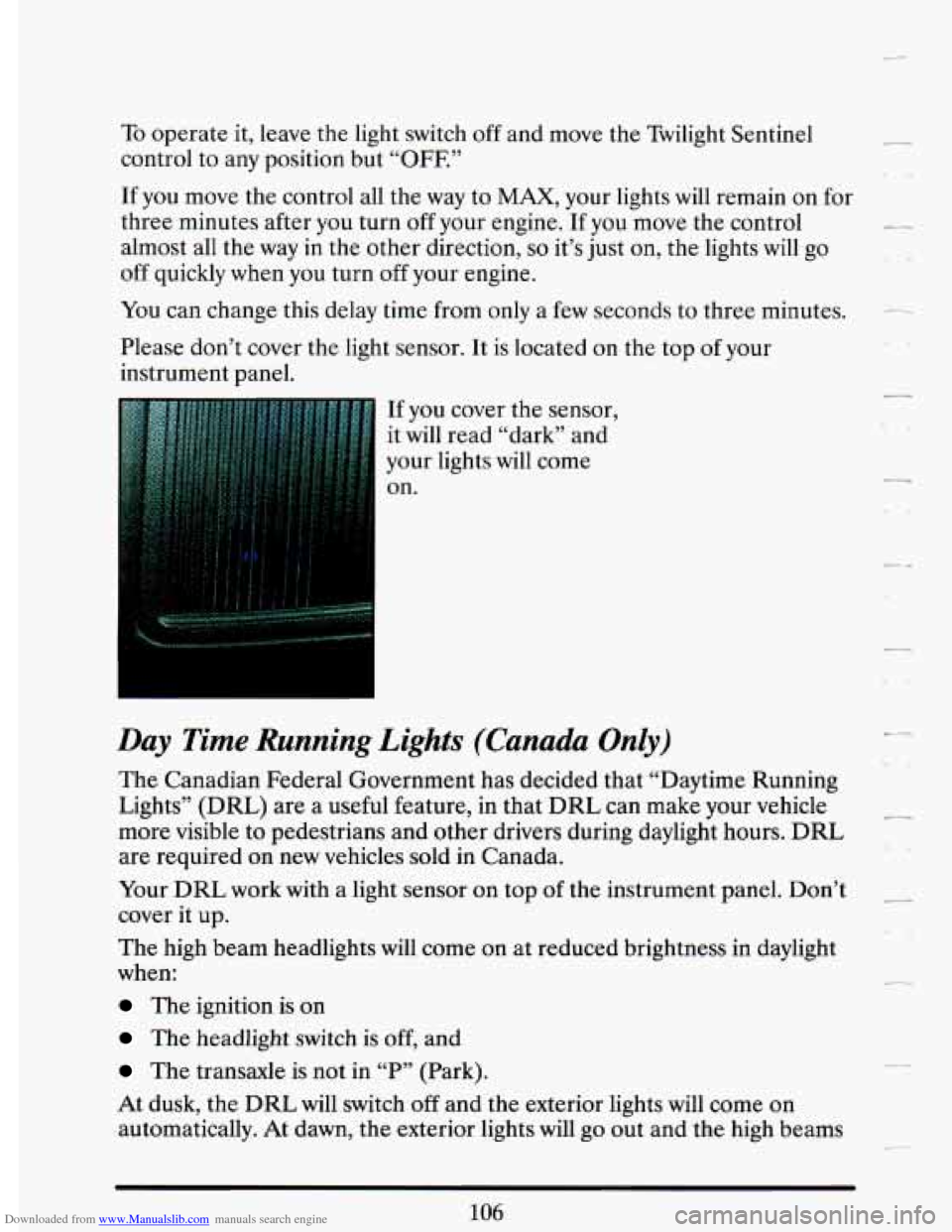
Downloaded from www.Manualslib.com manuals search engine To operate it, leave the light switch off and move the Twilight Sentinel
control
to any position but “OFE”
If you move the control all the way to MAX, your lights will remain on for
three minutes after you turn off your engine. If you move the control
almost all the way in the other direction,
so it’s just on, the lights will go
off quickly when you turn
off your engine.
You can change this delay time from only a
few seconds to three minutes. -
Please don’t cover the light sensor. It is located on the top of your
instrument panel.
If you cover the sensor,
it will read “dark” and
your lights will come
on.
‘I. i
Day Time Running Lights (Canada Only)
The Canadian Federal Government has decided that “Daytime Running
Lights” (DRL) are a useful feature, in that DRL can make your vehicle
more visible to pedestrians and other drivers during daylight hours. DRL
are required on new vehicles sold in Canada.
Your
DRL work with a light sensor on top of the instrument panel. Don’t -
cover it up.
The high beam headlights will come on at reduced brightness in daylight
when:
The ignition is on
The headlight switch is off, and
The transaxle is not in “P” (Park).
At dusk, the
DRL will switch off and the exterior lights will come on
automatically. At dawn, the exterior lights will
go out and the high beams
-
__ ~-
Page 120 of 406

Downloaded from www.Manualslib.com manuals search engine - will change to the reduced brightness of DRL (if the headlight switch is
off).
Of course, you may still turn on the headlights any time you need to.
To idle your vehicle with the DRL off, shift the transaxle into “P” (Park).
The
DRL will stay off until you shift out of “P” (Park).
---
- -- Rear Fog Lights (Export Only)
-- I
-- L
c_ To turn them on, push the switch located on the right lower side of your
instrument panel.
A small indicator light will glow to tell you they are on.
- ~. Cornering Lights
The cornering lights come on when you signal a turn. This will provide
more light for turning when its dark.
Maplights
--- The maplights are located above the rearview mirror. To operate the
maplights, just push either button to turn them on. They will both come
on when the courtesy lights are turned
on.
Page 122 of 406
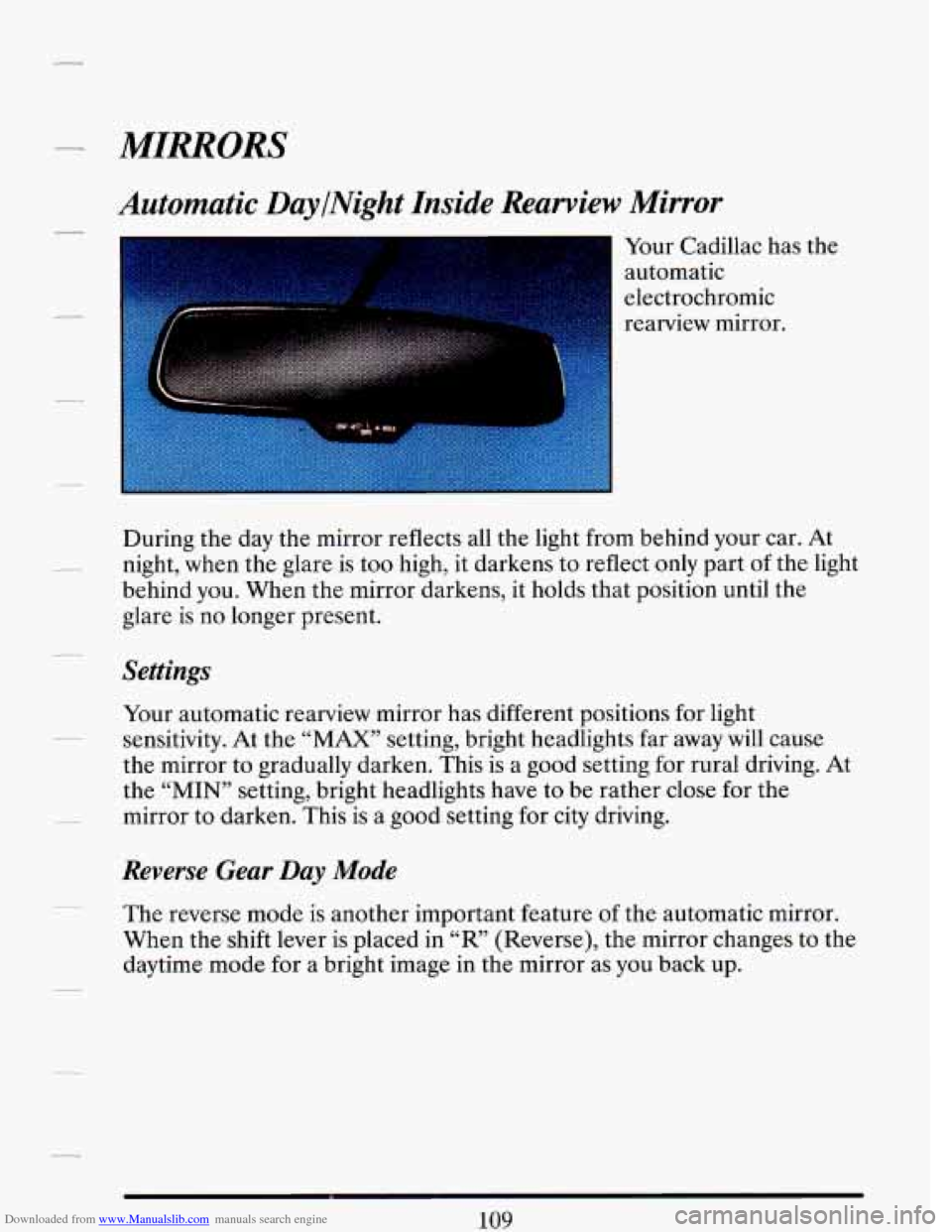
Downloaded from www.Manualslib.com manuals search engine 7 MIRRORS
Automatic DaylNight Inside Rearview Mirror
7
- Your Cadillac has the
automatic
electrochromic
rearview mirror.
During the day the mirror reflects all the light from behind your car. At
-. night, when the glare is too high, it darkens to reflect only part of the light
behind you. When the mirror darkens, it holds that position until the
glare is no longer present.
--
Settings
Your automatic rearview mirror has different positions for light
the mirror to gradually darken. This is a good setting for rural driving. At
the
“MIN” setting, bright headlights have to be rather close for the
__ sensitivity. At the “MAX” setting, bright headlights far away will cause
-. mirror to darken. This is a good setting for city driving.
Reverse Gear Day Mode
The reverse mode is another important feature of the automatic mirror.
When the shift lever is placed in
“R’ (Reverse), the mirror changes to the
daytime mode for a bright image in the mirror as you back up.
109
Page 207 of 406
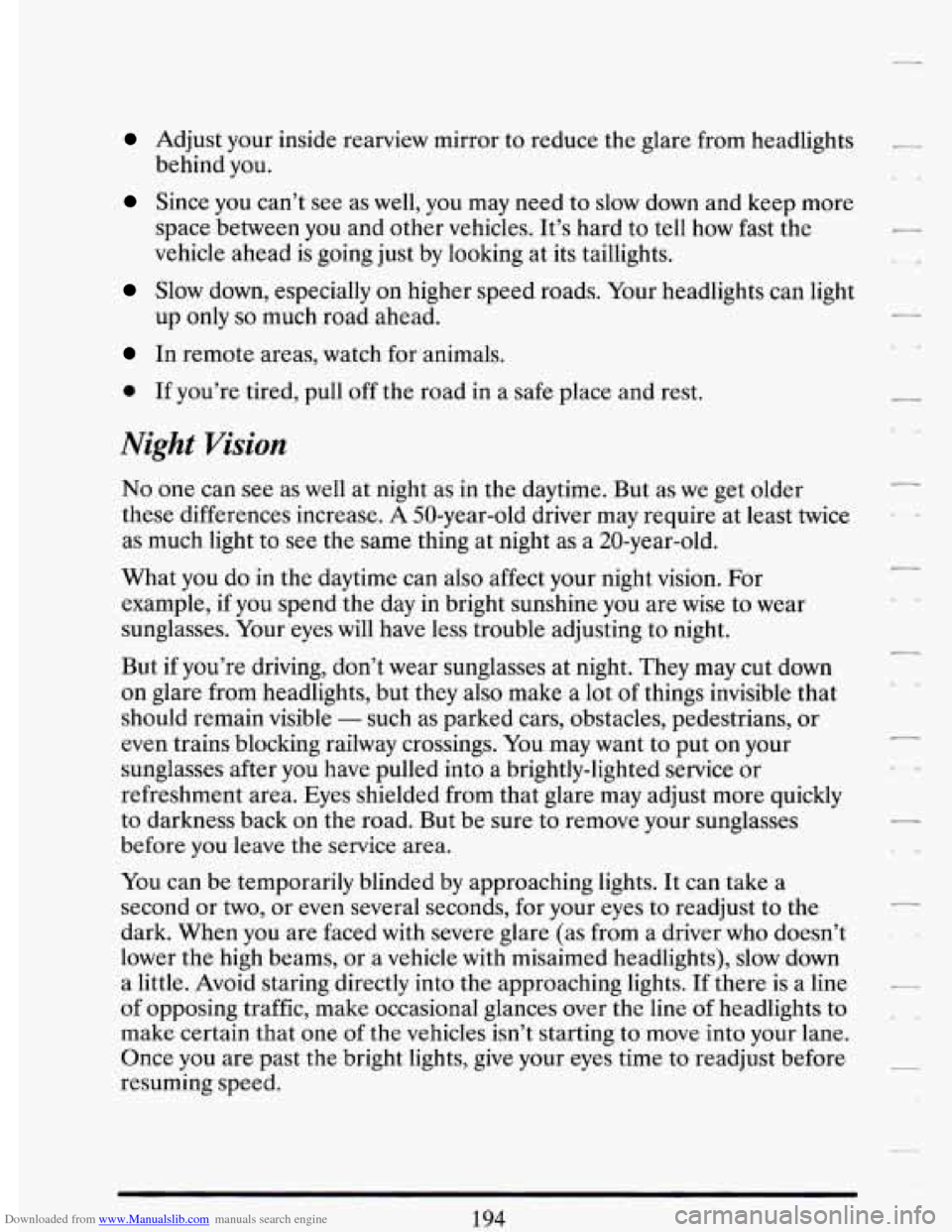
Downloaded from www.Manualslib.com manuals search engine Adjust your inside rearview mirror to reduce the glare from headlights
behind you.
Since you can’t see as well, you may need to slow down and keep more
space between you and other vehicles. It’s hard to tell how fast the
vehicle ahead is going just by looking at its taillights.
Slow down, especially on higher speed roads. Your headlights can light
up only
so much road ahead.
In remote areas, watch for animals.
0 If you’re tired, pull off the road in a safe place and rest.
Night Vision
No one can see as well at night as in the daytime. But as we get older
these differences increase.
A 50-year-old driver may require at least twice
as much light to see the same thing at night as a 20-year-old.
What you do in the daytime can also affect your night vision. For
example, if
you spend the day in bright sunshine you are wise to wear
sunglasses. Your eyes will have less trouble adjusting to night.
But if you’re driving, don’t wear sunglasses at night. They may cut down
on glare from headlights, but they also make a lot
of things invisible that
should remain visible
- such as parked cars, obstacles, pedestrians, or
even trains blocking railway crossings. You may want to put
on your
sunglasses after you have pulled into a brightly-lighted service or
refreshment area. Eyes shielded from that glare may adjust more quickly
to darkness back
on the road. But be sure to remove your sunglasses
before you leave the service area.
IOU can be temporarily blinded by approaching lights. It can take a
second or two, or
even several seconds, for your eyes to readjust to the
dark. When you are faced with severe glare (as from a driver who doesn’t
lower the high beams, or
a vehicle with misaimed headlights), slow down
a little. Avoid staring directly into the approaching lights.
If there is a line
of opposing traffic, make occasional glances over the line of headlights to
make certain that one
of the vehicles isn’t starting to move into your lane.
Once you are past the bright lights, give your eyes time to readjust before
resuming speed.
194
Page 208 of 406
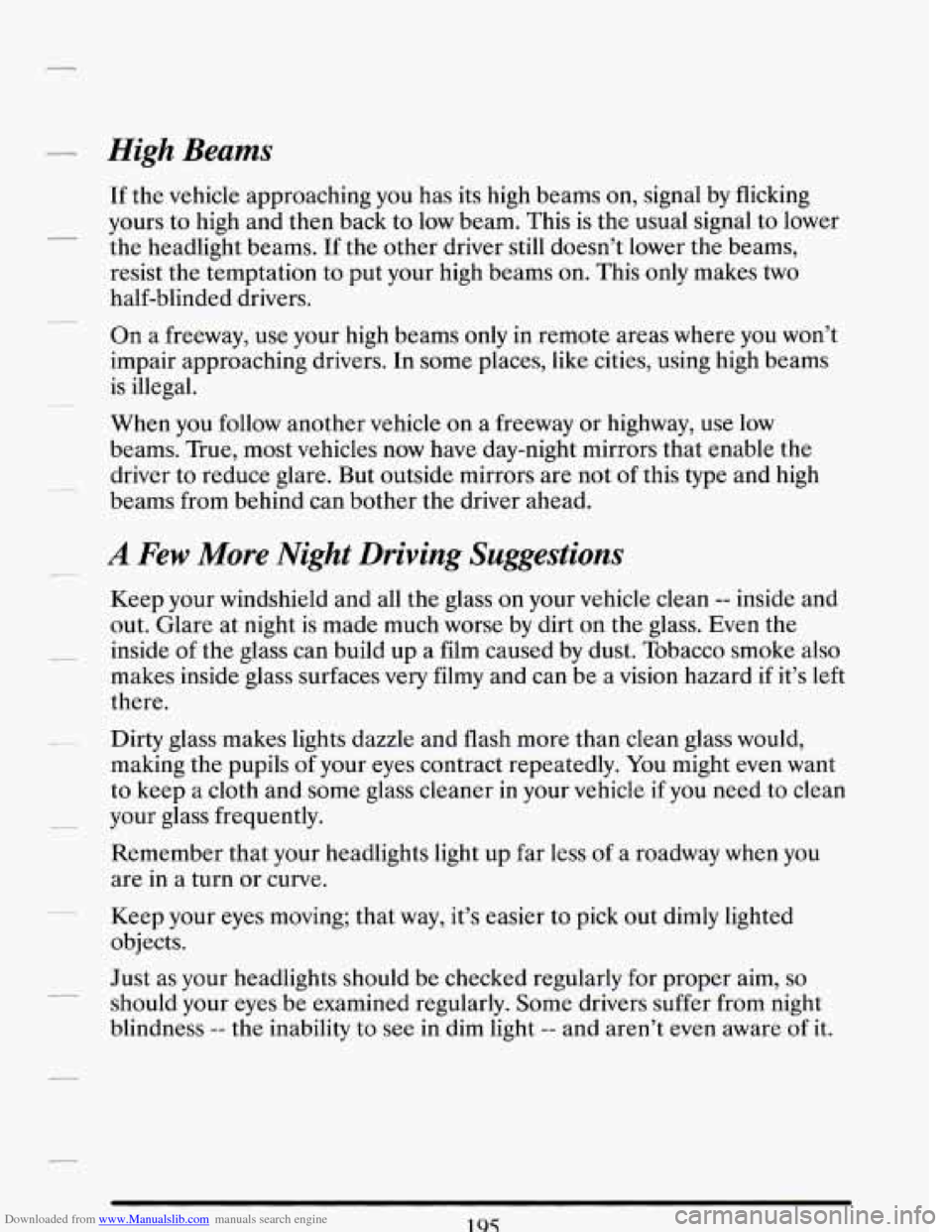
Downloaded from www.Manualslib.com manuals search engine - High Beams
If the vehicle approaching you has its high beams on, signal by flicking
yours to high and then back to low beam. This is the usual signal to
lower
the headlight beams. If the other driver still doesn’t lower the beams,
resist the temptation to put your high beams on. This only makes
two
half-blinded drivers.
7
On a freeway, use your high beams only in remote areas where you won’t
impair approaching drivers. In some places, like cities, using high beams
is illegal.
When you follow another vehicle on
a freeway or highway, use low
beams. True, most vehicles now have day-night mirrors that enable the
__ driver to reduce glare. But outside mirrors are not of this type and high
beams from behind can bother the driver ahead.
A Few More Night Driving Suggestions
Keep your windshield and all the glass on your vehicle clean -- inside and
out. Glare at night is made much worse by dirt on the glass. Even the
inside
of the glass can build up a film caused by dust. Tobacco smoke also
makes inside glass surfaces very filmy and can be a vision hazard if it’s left
there.
Dirty glass makes lights dazzle and flash more than clean glass would,
making the pupils
of your eyes contract repeatedly. You might even want
to keep a cloth and some glass cleaner
in your vehicle if you need to clean
- your glass frequently.
Remember that your headlights light up far less
of a roadway when you
are in a turn or curve.
Keep your eyes moving; that way, it’s easier to pick out dimly lighted
objects.
Just as your headlights should be checked regularly for proper aim,
so
should your eyes be examined regularly. Some drivers suffer from night
blindness
-- the inability to see in dim light -- and aren’t even aware of it.
195
Page 211 of 406
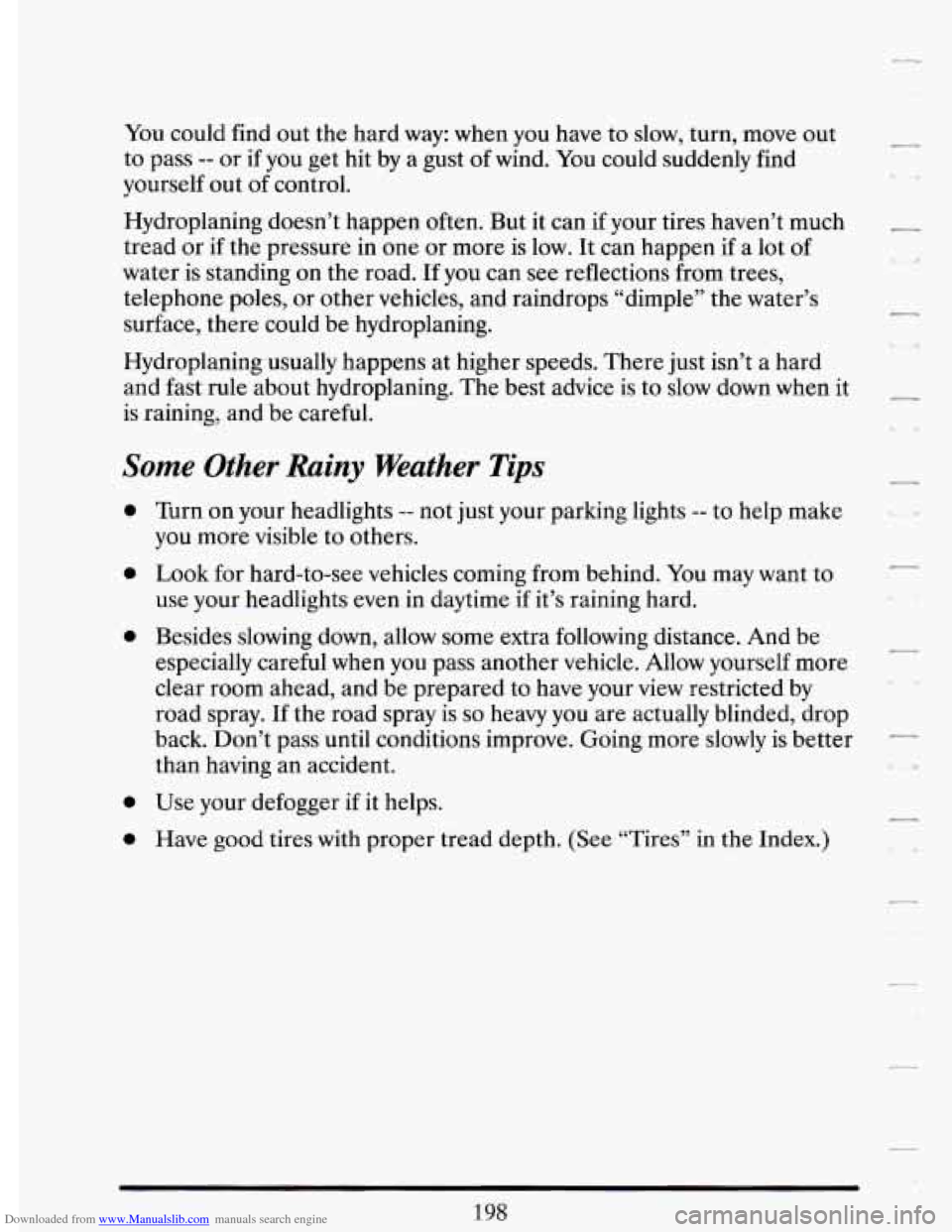
Downloaded from www.Manualslib.com manuals search engine You could find out the hard way: when you have to slow, turn, move out
to pass
-- or if you get hit by a gust of wind. You could suddenly find
yourself out of control.
Hydroplaning doesn’t happen often. But it can if your tires haven’t much
tread
or if the pressure in one or more is low. It can happen if a lot of
water is standing on the road. If you can see reflections from trees,
telephone poles, or other vehicles, and raindrops “dimple” the water’s
surface, there could be hydroplaning.
Hydroplaning usually happens at higher speeds. There just isn’t
a hard
and fast rule about hydroplaning. The best advice is to slow down when it
is raining, and be careful.
Some Other Rainy Weather Tips
0
0
0
0
0
Turn on your headlights -- not just your parking lights -- to help make
you more visible to others.
Look for hard-to-see vehicles coming from behind. You may want to
use your headlights even in daytime if it’s raining hard.
Besides slowing down, allow some extra following distance. And be
especially careful when you pass another vehicle. Allow yourself more
clear room ahead, and be prepared to have your view restricted by
road spray.
If the road spray is so heavy you are actually blinded, drop
back. Don’t pass until conditions improve. Going more slowly is better
than having an accident.
Use your defogger if it helps.
Have good tires with proper tread depth. (See “Tires”
in the Index.)
198
Page 212 of 406
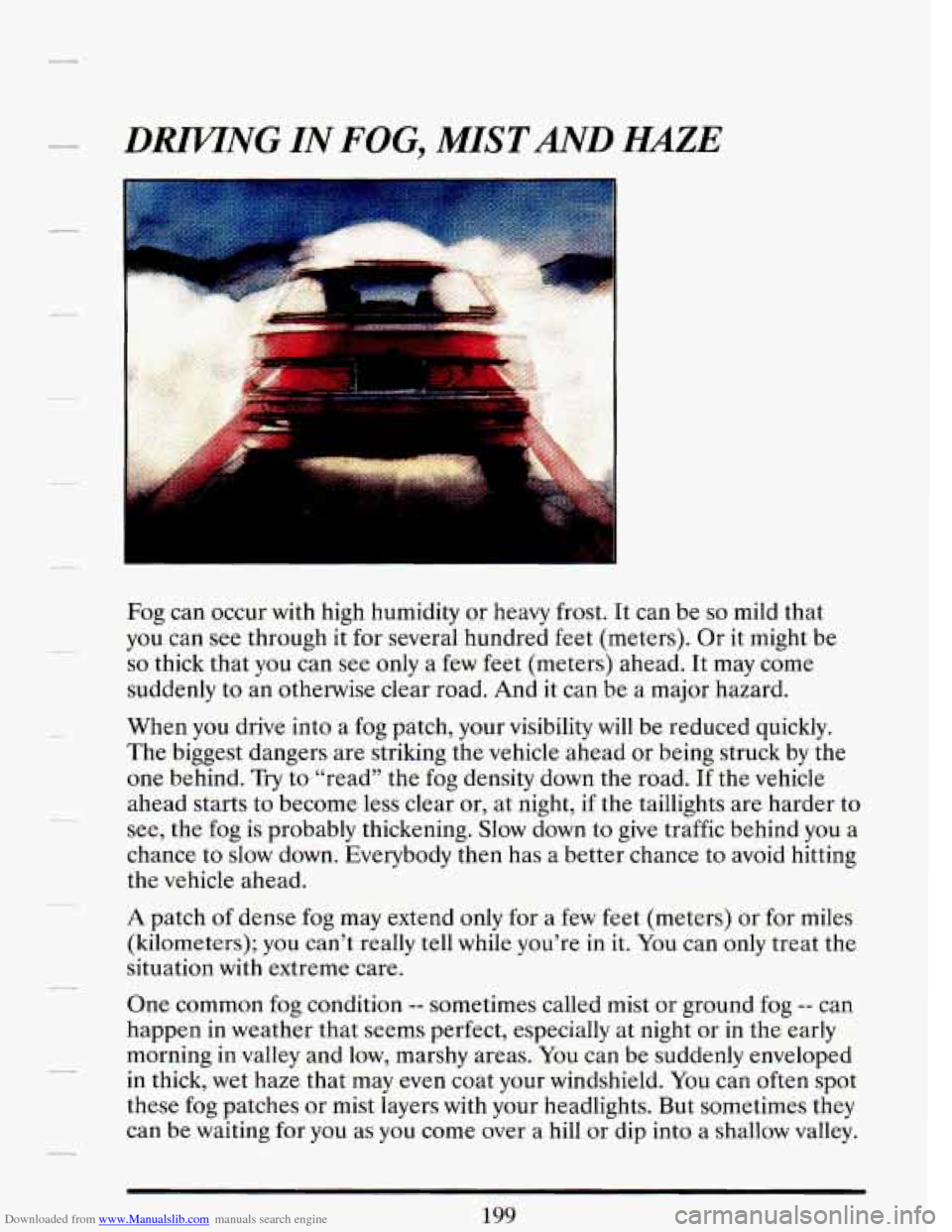
Downloaded from www.Manualslib.com manuals search engine DRZWNG IN FOG, MISTAND HAZE
d
. ..
Fog can occur with high humidity or heavy frost. It can be so mild that
you
can see through it for several hundred feet (meters). Or it might be
so thick that you can see only a few feet (meters) ahead. It may come
suddenly to an otherwise clear road. And it can be
a major hazard.
When you drive into a fog patch, your visibility will be reduced quickly.
The biggest dangers are striking the vehicle ahead or being struck by the
one behind.
Try to “read” the fog density down the road. If the vehicle
ahead starts to become less clear or, at night,
if the taillights are harder to
see, the fog is probably thickening. Slow down to give traffic behind you a
chance to slow down. Everybody then has a better chance to avoid hitting
the vehicle ahead.
A patch of dense fog may extend only for a few feet (meters) or for miles
(kilometers);
you can’t really tell while you’re in it. You can only treat the
situation with extreme care.
One common fog condition
-- sometimes called mist or ground fog -- can
happen
in weather that seems perfect, especially at night or in the early
morning in valley and low, marshy areas. You can be suddenly enveloped
in thick, wet haze that may even coat your windshield. You can often spot
these
fog patches or mist layers with your headlights. But sometimes they
can be waiting for you
as you come over a hill or dip into a shallow valley.